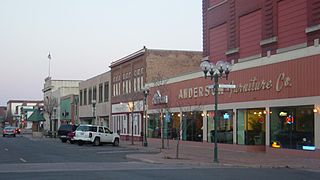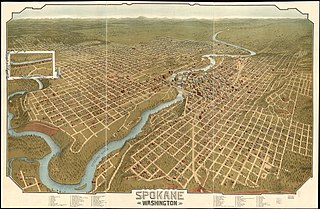
The Duluth MN–WI Metropolitan Area, commonly called the Twin Ports, is a small metropolitan area centered around the cities of Duluth, Minnesota and Superior, Wisconsin. The Twin Ports are located at the western part of Lake Superior and together are considered one of the larger cargo ports in the United States. The Twin Ports are close to many natural attractions such as the North Shore, the Apostle Islands, and the Superior National Forest.

The North Loop is a neighborhood in the Central community of Minneapolis.

Broad Street is a 15-mile-long (24 km) road located in the independent city of Richmond, Virginia, and adjacent Henrico County. Broad Street is significant to Richmond due to the many commercial establishments that have been built along it throughout Richmond's history. From downtown through miles into the suburbs, the street is largely dedicated to retailing and offices, including regional and neighborhood shopping centers and malls.

Duluth International Airport is a city-owned public-use joint civil-military airport located five nautical miles (9 km) northwest of the central business district of Duluth, a city in Saint Louis County, Minnesota, United States. It serves the Twin Ports area, including Superior, Wisconsin. Mostly used for general aviation but also served by three airlines, it is Minnesota's third-busiest airport, behind Minneapolis–St. Paul International Airport (MSP) and Rochester International Airport.

Duluth Central High School, also referred to as Central High School, was a secondary school in Duluth, Minnesota. It educated students in grades ten through twelve and later added seventh and eighth grades after the closure of Washington Junior High School in 1992. The original building at the intersection of Lake Avenue and Second Street first opened in 1893. On October 19, 2004, the building was given the official name, Historic Old Central High School.
West Duluth refers to an official neighborhood district in the west–central part of Duluth, Minnesota, United States.

Lincoln Park is a neighborhood in Duluth, Minnesota, United States. Located between Garfield Avenue and Carlton Street, it stretches up the hillside to Skyline Parkway. The neighborhood is named after the municipal park within its boundaries.

Canal Park is a tourist and recreation-oriented district of Duluth, Minnesota, United States. Situated across the Interstate 35 freeway from Downtown Duluth, it is connected by the Aerial Lift Bridge across the Duluth Ship Canal to the Park Point sandbar and neighborhood. Canal Park Drive and Lake Avenue South serve as the main routes in Canal Park.
Central Hillside is a neighborhood in Duluth, Minnesota, United States; located directly uphill from the city's downtown. The neighborhood offers views of the city and lake.

Duluth Heights is one of the largest neighborhoods in the city of Duluth, Minnesota, United States.

Minnesota Point, also known as the Park Point neighborhood of Duluth, Minnesota, United States; is a long, narrow sand spit that extends out from the Canal Park tourist recreation-oriented district of the city of Duluth. The Point separates Lake Superior from Superior Bay and the Duluth Harbor Basin.

Neighborhoods in Spokane, Washington are officially grouped by the Spokane City Council into three main city council districts: 1, 2, and 3. Each city council district contains multiple, official neighborhoods that are recognized with a neighborhood council. Informally, neighborhoods are colloquially grouped by local geographical, geological, cultural, or historical features The list of neighborhoods below is organized based on the official designations by the City of Spokane. Unofficial neighborhoods and districts are listed within the official neighborhood in which they are located.

Downtown Spokane or Riverside is the central business district of Spokane, Washington. The Riverside neighborhood is roughly bounded by I-90 to the south, Division Street to the east, Monroe Street to the west and Boone Avenue to the north. The topography of Downtown Spokane is mostly flat except for areas downstream of the Spokane Falls which are located in a canyon; the elevation is approximately 1,900 feet (580 m) above sea level.
Kenwood is a neighborhood in Duluth, Minnesota, United States.
East Hillside is a neighborhood in the City of Duluth, Minnesota, United States.

Lakeside – Lester Park is a neighborhood located in the eastern part of Duluth, Minnesota, situated along the North Shore of Lake Superior. Its landscape is marked by the expansive Lester Park and Lester River. The neighborhood is also characterized by its tree-lined streets and a commercial corridor that serves as a hub for local businesses and services. Lester Park Golf Course and Lester Park Elementary School are also located in the neighborhood.

The Gerald W. Heaney Federal Building, United States Courthouse and Custom House in Duluth, Minnesota, is a courthouse of the United States District Court for the District of Minnesota. Completed in 1930, it is part of the Duluth Civic Center Historic District, listed on the National Register of Historic Places in 1986. In 2007 the United States Congress passed an act to rename the building for former Circuit Court judge Gerald Heaney. It was enacted into law that same year.

Downtown Cincinnati is one of the 52 neighborhoods of Cincinnati, Ohio. It is the central business district of the city, as well the economic and symbiotic center of the Cincinnati metropolitan area. Originally the densely populated core of the city, the neighborhood was transformed into a commercial zone in the mid-20th century. The population was 5,835 at the 2020 census.

The Duluth Armory is a former armory and event venue in the East Hillside neighborhood of Duluth, Minnesota, United States. It was built in 1915 for the National Guard and naval militia, and expanded in 1941. From the beginning the National Guard also rented out the drill hall as an event venue, as it provided a larger and more flexible space than any other local venue until the construction of the Duluth Arena-Auditorium in 1966.

Downtown Des Moines is the central business district of Des Moines, Iowa and the Greater Des Moines Metropolitan Area. Downtown Des Moines is defined by the City of Des Moines as located between the Des Moines River to the east, the Raccoon River to the south, Center Street to the north, and 18th and 15th Streets to the west.























